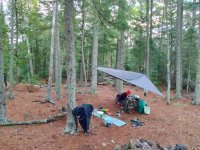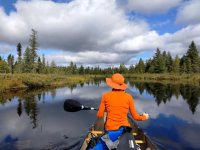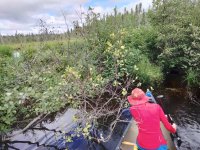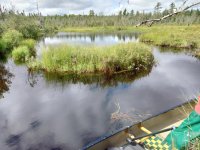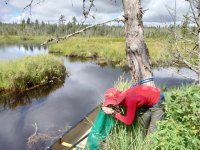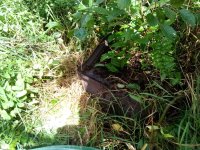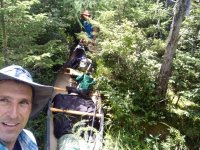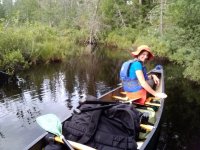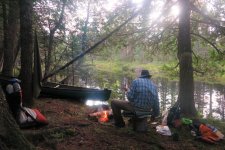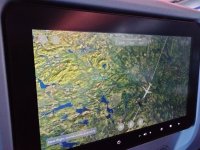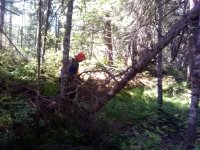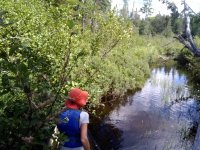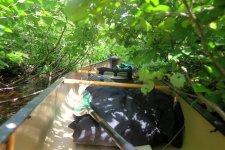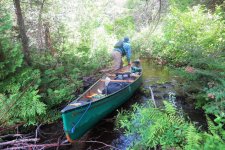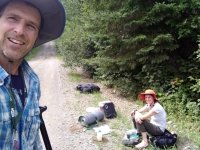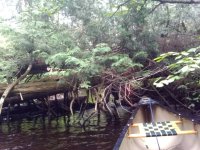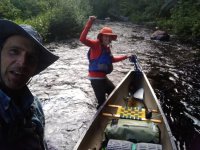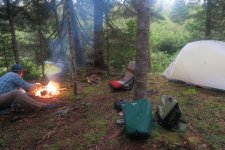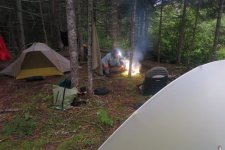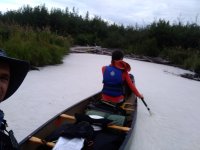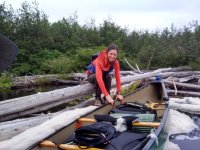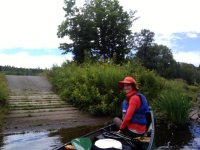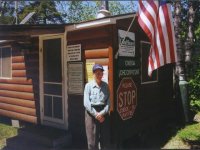This trip was something of a sequel to the Millinocket Carry, same crew (me and Hope) and same watersheds (East Branch of the Penobscot and Aroostook). Immediately after this trip I had a furball of work/travel and didn't have a chance to write up a trip report, and then it was a warm fall and I was trying to sneak in another solo trip or two so it basically fell through the cracks. Conversation over in the MC thread re some Downeast routes reminded me about it, and I thought I should finally write it up. This trip was in mid August.
During the trip I was having some camera issues (new phone camera sucks, old phone went in the drink, etc) but Hope brought a real camera and between the two of us we have pretty good coverage. (Assume the good stuff in the photo pool is hers.) As usual, at the really tough times we weren't taking many pictures, but how many photos of muck, alder and spruce thickets does the world need anyway?
We knew this crossing was once a canoe route because of some dotted lines on the old 1950's topo map. Who can resist a "Carry Brook" that's so prominent it has both an East and a West branch? Said brook empties into La Pomkeag Stream, and thence into the Aroostook River. It isn't in Ron Canter's guide, probably because it's farther from the Allagash, but it's that kind of route. We figured the trails would be long gone and knew it would be a slog but there were some options with parallel logging roads so we deemed it feasible. Unlike the MC, I hadn't been able to do any scouting in the field, so all we had to go on were the old maps and satellite imagery.
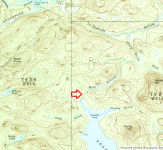
Trail to the West Branch of Carry Brook (1950's), catnip for canoeists. The large lake is Grand Lake Seboeis.
Day 0, 2022-08-11, Thursday
I'm calling this day zero since we didn't do much paddling -- only about half a mile.
The starting and ending points for this trip were a can't-get-there-from-here pair: Grand Lake Seboeis accessed from the road to Grand Lake Matagamon (i.e., one turns right/north on the way to the Baxter State Park north entrance), and a ramp on the Aroostook River off of the Oxbow Rd between Oxbow town and the NMW checkpoint (turn left on the way to Masardis). (Maybe we should call ourselves the Can't Get There from Here Canoe Club; need some decals.) We would have taken out in Masardis or Ashland, but we were a bit constrained on time and didn't know long the undocumented height of land crossing would take. Much of Thursday afternoon was consumed driving the long shuttle, while we watched the wet weather move in.
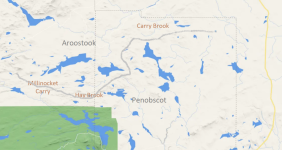
Three canoe routes from the Penobscot to the Aroostook
Excuse the doodle map above, but I wanted to give some context. The green area in the lower left is the northeastern corner of Baxter State Park, and the line at right is state highway 11. The gray freehand smear is the approximate watershed boundary. The Millinocket Carry, the Hay Brook / Beaver Brook route (trip report on the Northern Forest Canoe Trail site) and this route are all connections between the Penobscot and Aroostook watersheds.
We began our trip at the access to Grand Lake Seboeis (also a campsite), paddling east across the lake to a pleasant campsite on a small peninsula. We had 270 degree views from there and Hope caught a sunset photo between bouts of rain. It did rain, but it was August so really who cares.
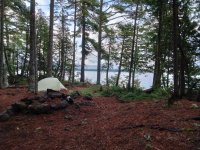
Campsite on the East side of Grand Lake Seboeis
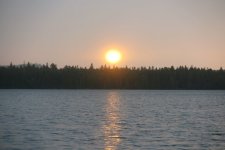
A break in the clouds at sunset
(More is coming but I'm on an airplane with sketchy wifi so I'm going to post this and continue. So far Xenforo is doing an admirable job of coping.)
During the trip I was having some camera issues (new phone camera sucks, old phone went in the drink, etc) but Hope brought a real camera and between the two of us we have pretty good coverage. (Assume the good stuff in the photo pool is hers.) As usual, at the really tough times we weren't taking many pictures, but how many photos of muck, alder and spruce thickets does the world need anyway?
We knew this crossing was once a canoe route because of some dotted lines on the old 1950's topo map. Who can resist a "Carry Brook" that's so prominent it has both an East and a West branch? Said brook empties into La Pomkeag Stream, and thence into the Aroostook River. It isn't in Ron Canter's guide, probably because it's farther from the Allagash, but it's that kind of route. We figured the trails would be long gone and knew it would be a slog but there were some options with parallel logging roads so we deemed it feasible. Unlike the MC, I hadn't been able to do any scouting in the field, so all we had to go on were the old maps and satellite imagery.

Trail to the West Branch of Carry Brook (1950's), catnip for canoeists. The large lake is Grand Lake Seboeis.
Day 0, 2022-08-11, Thursday
I'm calling this day zero since we didn't do much paddling -- only about half a mile.
The starting and ending points for this trip were a can't-get-there-from-here pair: Grand Lake Seboeis accessed from the road to Grand Lake Matagamon (i.e., one turns right/north on the way to the Baxter State Park north entrance), and a ramp on the Aroostook River off of the Oxbow Rd between Oxbow town and the NMW checkpoint (turn left on the way to Masardis). (Maybe we should call ourselves the Can't Get There from Here Canoe Club; need some decals.) We would have taken out in Masardis or Ashland, but we were a bit constrained on time and didn't know long the undocumented height of land crossing would take. Much of Thursday afternoon was consumed driving the long shuttle, while we watched the wet weather move in.

Three canoe routes from the Penobscot to the Aroostook
Excuse the doodle map above, but I wanted to give some context. The green area in the lower left is the northeastern corner of Baxter State Park, and the line at right is state highway 11. The gray freehand smear is the approximate watershed boundary. The Millinocket Carry, the Hay Brook / Beaver Brook route (trip report on the Northern Forest Canoe Trail site) and this route are all connections between the Penobscot and Aroostook watersheds.
We began our trip at the access to Grand Lake Seboeis (also a campsite), paddling east across the lake to a pleasant campsite on a small peninsula. We had 270 degree views from there and Hope caught a sunset photo between bouts of rain. It did rain, but it was August so really who cares.

Campsite on the East side of Grand Lake Seboeis

A break in the clouds at sunset
(More is coming but I'm on an airplane with sketchy wifi so I'm going to post this and continue. So far Xenforo is doing an admirable job of coping.)

